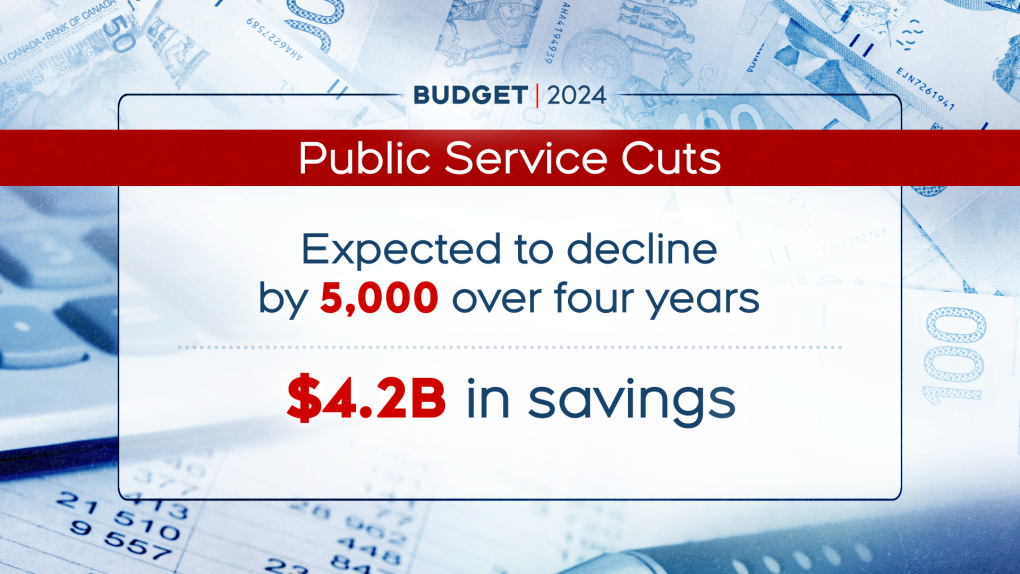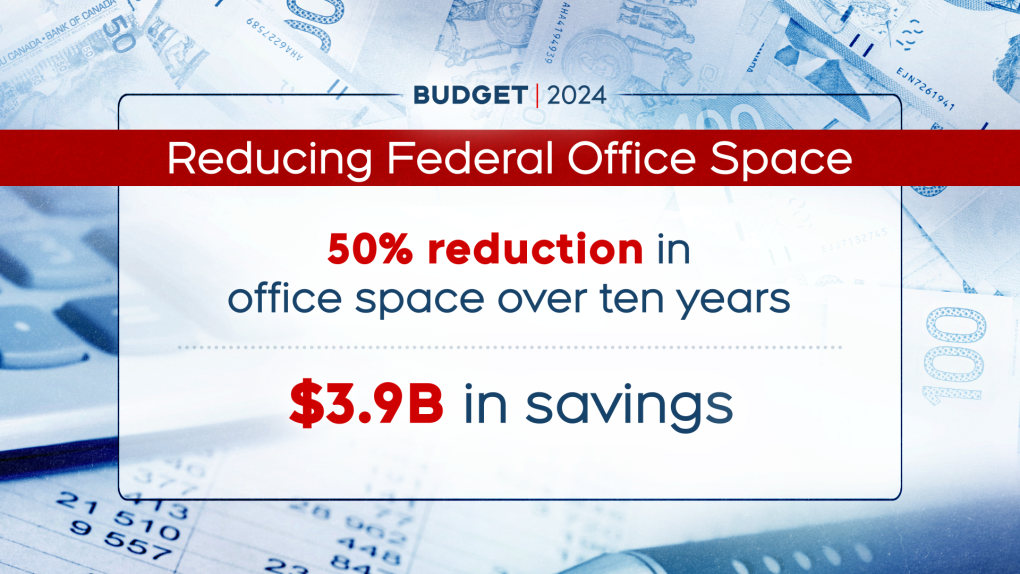Five thousand public service jobs will be eliminated over the next four years, while underused federal office buildings, Canada Post properties and the National Defense Medical Center in Ottawa could be converted into new housing units, while The federal government seeks to find billions of dollars in savings and boost the country’s housing portfolio.
The federal government’s 2024 budget outlines several initiatives for “responsible government spending” and converting federal properties into homes in the National Capital Region and across the country.
The 416-page document also proposes new disengagement rules for workers in federally regulated sectors to limit “work-related communication” outside of scheduled work hours.
CTV News looks at the federal government’s plans for the public service and its portfolio of offices outlined in the budget.
Cuts to public service
The federal government is seeking to eliminate 5,000 public service jobs through attrition over the next four years and require departments to cover rising costs within budgets, as part of the “second phase of reorienting government spending,” which seeks to save $4.2 billion over four years, starting 2025-26, and $1.3 billion going forward.
“The 2024 budget announces that the government will seek to achieve savings primarily through natural attrition in the federal public service,” the document says.
The budget calls for the “public service population” to decline by approximately 5,000 full-time equivalent positions over the next four years, down from 368,000 public service positions as of March 31, 2024. There were 357,274 federal public service employees as of March 31, 2024. March. 2023, according to federal officials.
Federal officials describe the elimination of the positions as a “modest” cut to public service. No specific figures were mentioned for job cuts in the national capital region.
As part of the spending plans, all federal departments and organizations will be required to cover a portion of their increased operating costs within their existing resources, beginning April 1, 2025.
“This measure will not affect the delivery of benefits to Canadians and will be implemented in a way that continues to support regional representation and a diverse workforce in the public service,” the federal budget says. “Going forward, the government will continue to review spending across all departments and on key initiatives to ensure the government operates effectively and efficiently for Canadians.”
Public Service Alliance of Canada president Chris Aylward tells CTV News he will be watching the budget implementation bill closely to find out how the cuts will affect his members.
“Any time jobs are cut or job losses like this are announced, we obviously worry about the services provided to Canadians,” he said. “You can’t cut jobs without cutting services. We don’t want to see long lines at airports and passport offices.”
It is still unknown how many of these positions to be eliminated will be in Ottawa and Gatineau.
The Canadian Center for Policy Alternatives warns that job cuts could affect services.
“I think what’s new about this is that there is an impact on staffing,” said David Macdonald, senior economist at the Canadian Center for Policy Alternatives.
“Previously, the promise involved no impact on service levels. That’s always the promise when government jobs are cut: that no one will see the result. Now we’re seeing that, oh, it’s going to hit staffing levels and well may affect service levels as a result.”
The 2023 budget and fall economic statement outlined plans to find $15.4 billion in public sector spending reductions by requiring departments and agencies to cut spending by three percent, but there were no concrete plans for how to achieve this.
In the 2024 budget, the government says the first phase of its “reorientation of government spending” identified areas of duplication, low profitability or “lack of alignment with government priorities.”
This year’s budget also provides $135 million to Public Services and Procurement Canada and the Treasury Board Secretariat to improve public service human resources and pay systems. The government is ordering officials to continue working on a “potential next-generation pay solution” to replace the Phoenix pay system.

The right to disconnect at work
The federal government is taking steps to give federal employees the “right to disconnect from work” outside of their normal work hours.
The budget proposes spending $3.6 million over five years to amend the Canada Labor Code to require employers in federally regulated sectors to establish a right-to-disconnect policy, “limiting work-related communication outside of business hours.” of work”.
“Everyone needs downtime – it’s essential for wellbeing and mental health,” Budget 2024 says.
“As the nature of work in many industries has become increasingly digital, workers are finding it increasingly difficult to disconnect from their devices and inboxes outside of work hours and on weekends.”
Up to 500,000 employees in federally regulated industries would be subject to the new right to disconnect from work policy.
Convert office buildings into homes
Public Service and Procurement Canada has been ordered to reduce its office portfolio by 50 per cent, allowing federal office buildings to potentially become homes in Ottawa and across Canada.
The budget provides $1.1 billion over 10 years, starting in 2024-25, for PSPC to convert underused federal offices into homes, with a focus on student and non-market housing.
“This funding will help expedite the completion of leases and disposition of underutilized federal properties, and address deferred maintenance,” the budget says.
The government says reducing the federal office’s footprint will generate “substantial savings,” expected to reach $3.9 billion over the next 10 years.

PSPC has more than six million square meters. of office space, and an estimated 50 percent of the space is underutilized or empty, according to the government.
In May 2023, the government announced that it would dispose of 10 buildings in the national capital region through sale or transfer. The buildings included the Jackson Building on Bank Street, the Sir Charles Tupper Building on Riverside Drive and L’Esplanade Laurier.
Aylward said this announcement is confusing.
“They’re still maintaining their two- or three-day office policy, but they’re also selling buildings, so it’s a bit of a confusing situation for us,” he said. “I think it’s good, but you really have to consider, when they say they’re going to start selling buildings, how many buildings do we really have? How many are leased?”
Construction of housing on national defense lands
The National Defense Medical Center in Ottawa could be converted into housing, as part of a plan to sell 14 surplus Department of National Defense buildings.
The budget says DND will work with Canada Lands Company and other partners to sell properties that have potential for housing. Properties include:
- The National Defense Medical Center in Ottawa
- The Amherst Armory in Amherst, NS
- 96 D’Auteuil and 87 St-Louis in Quebec City
- The HMCS Armory in Windsor, Ontario.
- Brigadier Murphy’s Armory in Vernon, BC
The National Defense Medical Center on Alta Vista Drive in Ottawa was a former full-service hospital built to care for military personnel and their families. The hospital officially opened in 1961 and ceased operations in the early 1990s.
As part of the budget, the federal government will provide “additional investments” for the Department of National Defense to build and renovate housing for Canadian Armed Forces personnel at bases across Canada.
The plan would support the construction of 1,400 new housing units and the renovation of 2,500 existing units for members on military bases in Ottawa, Petawawa, Kingston, Borden, Trenton, Valcartier, Gagetown, Esquimalt and Edmonton.
Wateridge Village
Nearly 500 new homes are being “urgently unlocked” in Ottawa’s Wateridge Village as part of the federal budget.
The federal government announced plans to create new housing on five federal properties across Canada.
In November, the government announced that 307 new homes would be developed in Wateridge Village, along with 600 homes at 299 Carling Avenue and 710 homes on Booth Street.
Wateridge Village was formerly home to Canadian Forces Base Rockcliffe.
Canada Post Properties
Canada Post properties in Manotick and Rockland could become available for housing as the federal government looks to reduce the crown corporation’s office space.
The budget says the government will take steps to allow Canada Post to prioritize leasing or divesting post office properties and land with “high potential for housing.”
Six Canada Post properties evaluated for housing development are:
- 1285 rue Notre-Dame Centre, Trois-Rivières, Que.
- 37 rue Saint-Laurent, Beauharnois, Que.
- 4 rue du Center Commercial, Roxboro, Que.
- 9702 Hardin Street, Fort McMurray, AB.
- 120 Charles Street, North Vancouver, British Columbia
- 45 Mary Street, Port Moody, British Columbia
The budget also mentions 33 properties that could be unlocked for housing across Canada, including Canada Post buildings in Manotick and Rockland.
